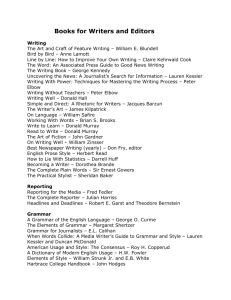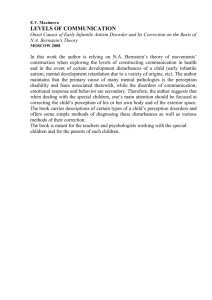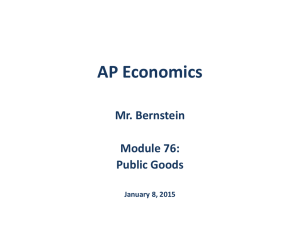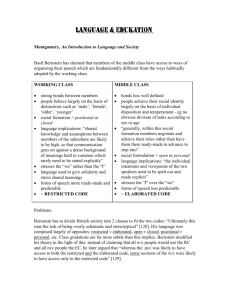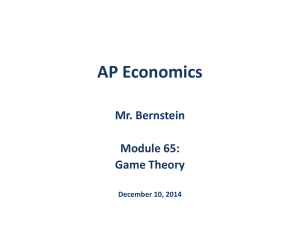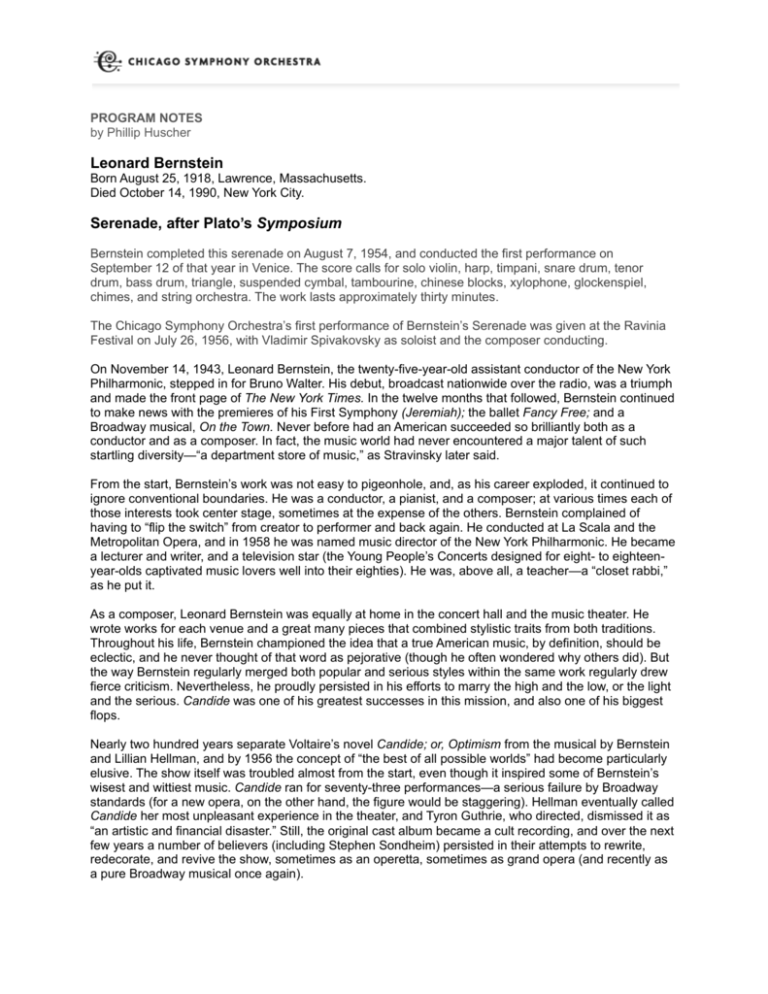
PROGRAM NOTES
by Phillip Huscher
Leonard Bernstein
Born August 25, 1918, Lawrence, Massachusetts.
Died October 14, 1990, New York City.
Serenade, after Plato’s Symposium
Bernstein completed this serenade on August 7, 1954, and conducted the first performance on
September 12 of that year in Venice. The score calls for solo violin, harp, timpani, snare drum, tenor
drum, bass drum, triangle, suspended cymbal, tambourine, chinese blocks, xylophone, glockenspiel,
chimes, and string orchestra. The work lasts approximately thirty minutes.
The Chicago Symphony Orchestra’s first performance of Bernstein’s Serenade was given at the Ravinia
Festival on July 26, 1956, with Vladimir Spivakovsky as soloist and the composer conducting.
On November 14, 1943, Leonard Bernstein, the twenty-five-year-old assistant conductor of the New York
Philharmonic, stepped in for Bruno Walter. His debut, broadcast nationwide over the radio, was a triumph
and made the front page of The New York Times. In the twelve months that followed, Bernstein continued
to make news with the premieres of his First Symphony (Jeremiah); the ballet Fancy Free; and a
Broadway musical, On the Town. Never before had an American succeeded so brilliantly both as a
conductor and as a composer. In fact, the music world had never encountered a major talent of such
startling diversity—“a department store of music,” as Stravinsky later said.
From the start, Bernstein’s work was not easy to pigeonhole, and, as his career exploded, it continued to
ignore conventional boundaries. He was a conductor, a pianist, and a composer; at various times each of
those interests took center stage, sometimes at the expense of the others. Bernstein complained of
having to “flip the switch” from creator to performer and back again. He conducted at La Scala and the
Metropolitan Opera, and in 1958 he was named music director of the New York Philharmonic. He became
a lecturer and writer, and a television star (the Young People’s Concerts designed for eight- to eighteenyear-olds captivated music lovers well into their eighties). He was, above all, a teacher—a “closet rabbi,”
as he put it.
As a composer, Leonard Bernstein was equally at home in the concert hall and the music theater. He
wrote works for each venue and a great many pieces that combined stylistic traits from both traditions.
Throughout his life, Bernstein championed the idea that a true American music, by definition, should be
eclectic, and he never thought of that word as pejorative (though he often wondered why others did). But
the way Bernstein regularly merged both popular and serious styles within the same work regularly drew
fierce criticism. Nevertheless, he proudly persisted in his efforts to marry the high and the low, or the light
and the serious. Candide was one of his greatest successes in this mission, and also one of his biggest
flops.
Nearly two hundred years separate Voltaire’s novel Candide; or, Optimism from the musical by Bernstein
and Lillian Hellman, and by 1956 the concept of “the best of all possible worlds” had become particularly
elusive. The show itself was troubled almost from the start, even though it inspired some of Bernstein’s
wisest and wittiest music. Candide ran for seventy-three performances—a serious failure by Broadway
standards (for a new opera, on the other hand, the figure would be staggering). Hellman eventually called
Candide her most unpleasant experience in the theater, and Tyron Guthrie, who directed, dismissed it as
“an artistic and financial disaster.” Still, the original cast album became a cult recording, and over the next
few years a number of believers (including Stephen Sondheim) persisted in their attempts to rewrite,
redecorate, and revive the show, sometimes as an operetta, sometimes as grand opera (and recently as
a pure Broadway musical once again).
The brilliant overture, virtually alone among Candide’s many numbers, has emerged unscathed from the
experience. It remains one of the most affecting of Bernstein’s creations—a charming and sassy curtain
raiser based on two of the show’s best tunes, “Oh Happy We” and Cunegonde’s jewel song, “Glitter and
Be Gay.” Bernstein himself once called it a valentine to European music. Above all, it is delightful
evidence of Bernstein’s belief that “man’s capacity for laughter is nobler than his divine gift of suffering.”
The Serenade, which is one of Bernstein’s finest concert-hall works, follows Wonderful Town, which
opened on Broadway in 1953, and the film score for On the Waterfront, and was composed while
Bernstein’s life was “all Lillian Hellman and Candide.” In that context, Bernstein insisted on subtitling the
serenade “after Plato’s Symposium” to underline the seriousness of his intentions. Still, even with its use
of fugato and sonata form, the serenade is above all a grand entertainment. On August 8, 1954, the day
after he completed the score, Bernstein wrote the following comments.
Leonard Bernstein on the Serenade
There is no literal program for this serenade, despite the fact that it resulted from a rereading of Plato’s
charming dialogue, The Symposium. The music, like the dialogue, is a series of related statements in praise
of love, and generally follows the Platonic form through the succession of speakers at the banquet. The
“relatedness” of the movements does not depend on common thematic material, but rather on a system
whereby each movement evolves out of elements in the preceding one.
For the benefit of those interested in literary allusion, I might suggest the following points as guideposts:
I. Phaedrus—Pausanias (Lento—Allegro): Phaedrus opens the symposium with a lyrical oration in praise of
Eros, the god of love. (Fugato, begun by the solo violin.) Pausanias continues by describing the duality of
lover and beloved. This is expressed in a classical sonata-allegro, based on the material of the opening
fugato.
II. Aristophanes (Allegretto): Aristophanes does not play the role of clown in this dialogue, but instead that of
the bedtime storyteller, invoking the fairy-tale mythology of love.
III. Erixymachus (Presto): The physician speaks of bodily harmony as a scientific model for the workings of
love-patterns. This is an extremely short fugato scherzo, born of a blend of mystery and humor.
IV. Agathon (Adagio): Perhaps the most moving speech of the dialogue, Agathon’s panegyric embraces all
aspects of love’s powers, charms, and functions. This movement is a simple three-part song.
V. Socrates—Alcibiades (Molto tenuto—Allegro molto vivace): Socrates describes his visit to the seer
Diotima, quoting her speech on the demonology of love. This is a slow introduction of greater weight than
any of the preceding movements and serves as a highly developed reprise of the middle section of the
Agathon movement, thus suggesting a hidden sonata form. The famous interruption by Alcibiades and his
band of drunken revelers ushers in the Allegro, which is an extended rondo ranging in spirit from agitation
through jiglike dance music to joyful celebration. If there is a hint of jazz in the celebration, I hope it will not
be taken as anachronistic Greek party music, but rather the natural expression of a contemporary American
composer imbued with the spirit of that timeless dinner party.
Phillip Huscher is the program annotator for the Chicago Symphony Orchestra.
© Chicago Symphony Orchestra. All rights reserved. Program notes may be reproduced only in their
entirety and with express written permission from the Chicago Symphony Orchestra.
These notes appear in galley files and may contain typographical or other errors. Programs subject to
change without notice.
2

